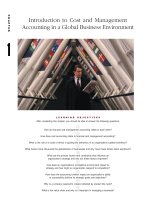Cost accounting chapter 07
Bạn đang xem bản rút gọn của tài liệu. Xem và tải ngay bản đầy đủ của tài liệu tại đây (932.97 KB, 21 trang )
Flexible Budgets,
Direct-Cost Variances,
and
Management Control
© 2009 Pearson Prentice Hall. All rights reserved.
Basic Concepts
Variance – difference between an actual and
an expected (budgeted) amount
Management by Exception – the practice of
focusing attention on areas not operating as
expected (budgeted)
Static (Master) Budget – is based on the
output planned at the start of the budget
period
© 2009 Pearson Prentice Hall. All rights reserved.
Basic Concepts
Static-Budget Variance (Level 0) – the
difference between the actual result and the
corresponding static budget amount
Favorable Variance (F) – has the effect of
increasing operating income relative to the
budget amount
Unfavorable Variance (U) – has the effect of
decreasing operating income relative to the
budget amount
© 2009 Pearson Prentice Hall. All rights reserved.
Variances
Variances may start out “at the top” with a
Level 0 analysis.
This is the highest level of analysis, a supermacro view of operating results.
The Level 0 analysis is nothing more than the
difference between actual and static-budget
operating income
© 2009 Pearson Prentice Hall. All rights reserved.
Variances
Further analysis decomposes (breaks down)
the Level 0 analysis down into progressively
smaller and smaller components
Answers: “How much were we off?”
Levels 1, 2, and 3 examine the Level 0
variance into progressively more-detailed
levels of analysis
Answers: “Where and why were we off?”
© 2009 Pearson Prentice Hall. All rights reserved.
Level 1 Analysis, Illustrated
© 2009 Pearson Prentice Hall. All rights reserved.
Evaluation
Level 0 tells the user very little other than
how much Contribution Margin was off from
budget.
Level 0 answers the question: “How much were we
off in total?”
Level 1 gives the user a little more
information: it shows which line-items led to
the total Level 0 variance.
Level 1 answers the question: “Where were we off?”
© 2009 Pearson Prentice Hall. All rights reserved.
Flexible Budget
Flexible Budget – shifts budgeted revenues
and costs up and down based actual
operating results (activities)
Represents a blending of actual activities and
budgeted dollar amounts
Will allow for preparation of Level 2 and 3
variances
Answers the question: “Why were we off?”
© 2009 Pearson Prentice Hall. All rights reserved.
Level 2 Analysis, Illustrated
© 2009 Pearson Prentice Hall. All rights reserved.
Level 3 Analysis, Illustrated
© 2009 Pearson Prentice Hall. All rights reserved.
Level 3 Variances
All Product Costs can have Level 3 Variances.
Direct Materials and Direct Labor will be
handled next. Overhead Variances are
discussed in detail in a later chapter
Both Direct Materials and Direct Labor have
both Price and Efficiency Variances, and their
formulae are the same
© 2009 Pearson Prentice Hall. All rights reserved.
Variance Summary
© 2009 Pearson Prentice Hall. All rights reserved.
Level 3 Variances
Price Variance formula:
Efficiency Variance formula:
(c) 2009 Pearson Prentice Hall. All rights reserved.
Variances & Journal Entries
Each variance may be journalized
Each variance has its own account
Favorable variances are credits; Unfavorable
variances are debits
Variance accounts are generally closed into
Cost of Goods Sold at the end of the period, if
immaterial
© 2009 Pearson Prentice Hall. All rights reserved.
Standard Costing
Budgeted amounts and rates are actually
booked into the accounting system
These budgeted amounts contrast with actual
activity and give rise to Variance Accounts.
© 2009 Pearson Prentice Hall. All rights reserved.
Standard Costing
Reasons for implementation:
Improved software systems
Wide usefulness of variance information
© 2009 Pearson Prentice Hall. All rights reserved.
Management Uses of Variances
To understand underlying causes of variances.
Recognition of inter-relatedness of variances
Performance Measurement
Managers ability to be Effective
Managers ability to be Efficient
© 2009 Pearson Prentice Hall. All rights reserved.
Activity-Based Costing and Variances
ABC easily lends its to budgeting and variance
analysis.
Budgeting is not conducted on the
departmental-wide basis (or other macro
approaches)
Instead, budgets are built from the bottom-up
with activities serving as the building blocks of
the process
© 2009 Pearson Prentice Hall. All rights reserved.
Benchmarking and Variances
Benchmarking is the continuous process of
comparing the levels of performance in
producing products & services against the
best levels of performance in competing
companies
Variances can be extended to include
comparison to other entities
© 2009 Pearson Prentice Hall. All rights reserved.
Benchmarking Example: Airlines
© 2009 Pearson Prentice Hall. All rights reserved.
© 2009 Pearson Prentice Hall. All rights reserved.









